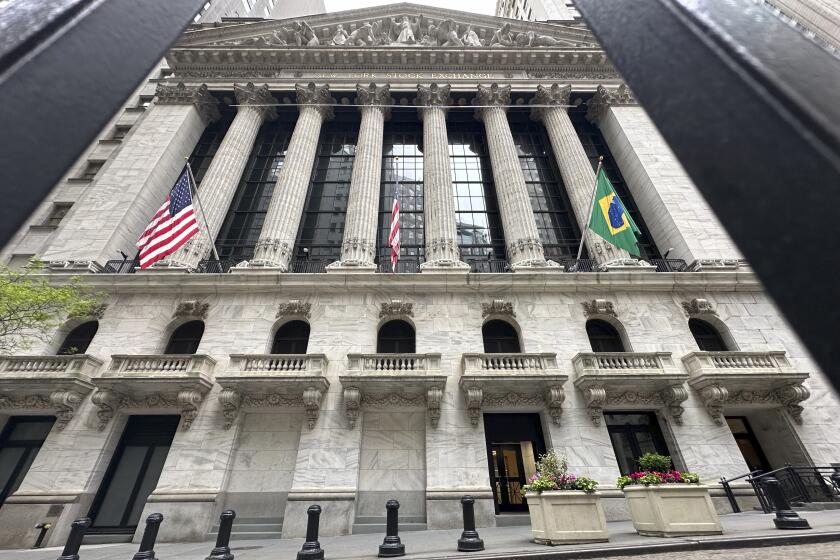Southland Firms Facing a Profit Squeeze
The late summer jump in oil prices, now working its way through the economy, promises to squeeze the profit margins of small- and mid-sized Southland manufacturers.
For many of the firms, the price hikes their suppliers are seeking couldn’t come at a worse time because demand is slowing in key product lines as the economy weakens.
That means the manufacturers could once again be left holding the bag as they were frequently forced to do in the troubled economy of the early and mid-1980s. One result is likely to be rising layoffs at smaller firms, which are the backbone of the economy.
An informal canvass of manufacturers in the region shows many are being hit with price increases of 4% to 6% from suppliers, who justify the moves with a variety of explanations.
* For companies such as Bridgford Foods in Anaheim, a meat and cheese products firm, packaging companies are raising prices, citing the higher cost of oil used to produce plastic wrap and other supplies.
“We’re fighting with our suppliers over those costs,” says Robert Schulze, Bridgford’s treasurer. Bridgford’s costs already had been on the rise because of higher prices for raw pork, which has been in extremely short supply, Schulze says.
* Companies that buy resins and other oil-based raw materials to produce plastic parts and other goods are seeing price increases from any supplier that isn’t locked into a long-term contract.
For example, Cimco Inc., a Costa Mesa-based manufacturer of such products as plastic cases for computer printers and intravenous fittings for medical use, is being asked to pay about 5% more for some spot-contract materials, says Laurance Simmons, chief financial officer.
* Many manufacturers are getting billed surcharges for suppliers’ increased transportation costs because of higher diesel and gasoline prices. A survey by the Los Angeles Area Chamber of Commerce in October showed gas prices up 40% to 50% from a year ago, making it easy for suppliers to justify surcharges to the companies they serve.
More than a few manufacturers grumble that suppliers are using oil just as an excuse to boost prices. “I really question it,” says one Southland financial executive.
But some manufacturers also say that, in many cases, the business shakeout of the ‘80s left fewer raw materials suppliers in many key industries. Suppliers who survived are stronger and have more leverage over manufacturers.
As their costs rise, manufacturers then are left in the uncomfortable position of trying to raise prices to their customers. But many admit that, as the economy slumps, passing along increases is becoming much tougher. So the companies face shrinking profit margins, which for the average U.S. manufacturer already have dropped from a peak of 6.3% in 1988 to 5% at midyear.
El Segundo-based Farr Co., which makes a variety of filters for trucks, heating and air conditioning systems and other uses, is trying to raise its prices 2.5% across the board starting Jan. 1, says Jack Carr, chief financial officer. Those hikes would help offset 5% to 6% price increases from some suppliers, he says.
“We typically don’t raise prices across the board,” Carr says, but the decision was made to try to preserve the company’s profit margins. Yet Carr admits that the price increases could be a hard sell in some product lines where demand is weak, such as truck fuel filters.
In Commerce, Anthony Industries, a producer of plastic-based recreational goods including swimming pools and fishing tackle, has some price increases scheduled for later in the year, says John Rangel, senior vice president for finance. But Anthony, too, is seeing weakness in key markets, especially pool sales in the East.
Cimco, meanwhile, is trying to renegotiate price-increase trigger clauses with some customers, Simmons says. Cimco typically can raise prices if its own costs rise more than 5%. Simmons says the firm is “trying to reduce that (trigger) to about 3%” to avoid seeing profit margins nibbled away by supplier price increases of 4% to 4.5%.
Some Southland companies say they aren’t yet having much trouble passing through their higher costs. Richard Hamill, president of Hycor Biomedical in Garden Grove, says the 5% to 6% hikes he has faced from plastics and glass suppliers are manageable so far. His firm makes diagnostic products used in urinalysis and disease detection.
No matter what their pricing situation, however, most manufacturers say they have redoubled efforts in recent months to cut internal expenses--and shrink inventories--in anticipation of a worsening economy and falling profit margins. The irony of those austerity measures is that, short term, they are likely to accelerate the Southland’s economic slide.
“The natural thing is to cut back because you’re scared to death that profits are going to look miserable next year,” says Jack Kyser, chief economist at the L.A. Area Chamber of Commerce. But when multiplied throughout the economy, the spending cuts ripple through other businesses and start a chain reaction of cutbacks, he notes.
Farr Co.’s Carr says there’s a good reason to be “out front much earlier” with tight inventory controls and other cutbacks: “If you react early, you may be able to get away with a small layoff later” rather than a major staff cut, he says.
Some experts, however, warn that manufacturers should be braced for a steep decline in profit margins in 1991--and a new round of cost cutting and layoffs--regardless of how much they’ve already cut.
At the depths of the 1982 recession, profit margins fell to a mere 2.8% of sales for the average U.S. manufacturer. Since then, manufacturers have been raising their productivity by 4% to 5% a year by constantly streamlining their businesses, says Claremont Institute economist John Rutledge.
But the impact of higher energy costs, continuing high service-sector inflation and weakening demand will once again crunch the typical manufacturer in the year ahead, Rutledge says. In fact, he says, the danger for many manufacturers may be that they will face deflationary pressure--a push to actually cut prices to keep sales up.
That will drive more companies to abandon marginal product lines, leaving them only in their absolute best businesses, Rutledge says.
“If your customer won’t give you a price increase, and your service costs are going up, there’s only (one) lever you can pull,” he says. “You’ve got to find the assets that it doesn’t pay to carry and get rid of them.”
MANUFACTURERS’ PROFIT MARGINS
The economic slowdown is likely to lead to another severe profit crunch for many companies. How U.S. manufacturers’ after-tax profit margins ebbed and flowed over the past 10 years:






